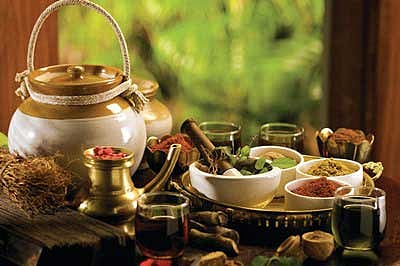(d) Samagni: Balanced state of agni (controlled digestive fire)
When all the three dosas – Vata, Pitta and Kapha are in balance, Jatharagni is also in balance, and food is consumed in the proper proportion and digested well in time. This state is called ‘samagni’ (balanced state of agni). There is no abnormality in the digestive process in this state. It is an ideal agni for health and normal digestion.
Dosas and Jatharagni
Agni or the digestive fire aids in digestion and assimilation. Here it is important to mention that due to dosas, the intensity of agni is also affected.
Dosa Level of agni
Vata Irregular (sometimes intense, sometimes slow)
Pitta Intense (acute)
Kapha Slow (sluggish)
Vata, Pitta, Kapha in equilibrium Stable agni (balanced state)
This group of agnis is located in the liver. They are five in number according to the five elements they act upon: 1. Bhaumagni (earth); 2. Apyagni (water); 3. Agniydgni (fire); 4. Vayavyagni (air); and 5. Akasagni (space or ether).
Each of these agnis transform the corresponding elements present in the food that has already been broken down by Jatharagni to match the state of the same element already in the body and its tissues. Thus, these bhutagnis located in the liver divide food into five parts which nourish the five elements found in different parts of the body.
Dhatvagnis is the third group of agnis found in the body. They help in normal metabolic transformation of tissues. When anna rasa (nutrient-plasma), which has been transformed into five elements by the action of Jatharagni and bhutagnis, reaches the channels of the dhatus, it is further digested by the dhatvagnis located there. This nutrient-plasma (anna rasa) gets transformed into rasa, rakta and other dhatus. Since dhatus are seven in number, so are the seven dhatvagnis. These dhatvagnis are named after the tissue that they work on: 1. Rasagni; 2. Raktagni; 3. Mamsdgni; 4. Meddgni; 5. Asthiagni; 6. Majjdgni; 1. Sukragni (in males) and Rajogni (in females).
The action of these agnis regenerates the dhatus and also produce malas (waste products) within them. When the dhatvagnis are aggravated, it leads to a corresponding decrease in the dhatus and vice a versa. When dhatvagni burns too high, dhatus cannot build up to their normal quantity. Conversely, low intensity in the dhatvagnis leads to an increased dhatu formation. When the dhatvagni burns too low, more of the dhatu is built up, but it’s generally of an inferior quality. The entire digestive process due to the action of the three types of agnis is briefly explained as follows:
When food reaches the mouth, it is mixed with saliva and its taste is perceived by the tongue. The food then moves into the stomach where solid food particles turn watery, foamy and soft due to the action of the gastric acids and digestive juices which are liquid and greasy. In this first step of digestion, foamy Kapha and madhura rasa (sweet taste) are produced. The digestion of food in the stomach is normal at this time. This half-digested food essence (ahara rasa) reaches the small intestine through the duodenum. Here jathardgni acts on it together with samana-vayu and pacaka pitta. Pacaka Pitta absorbs the liquid part of the ahara rasa, converting it into a solid mass, which is referred to as ‘pinda.’ Katu rasa (pungent taste) and Vata are produced during this stage. Here food is segregated into two parts: 1. sara or prasad, and 2. asara or kitta.
The properly digested part of the food which is in liquid form is the sara part. This forms the first of the seven dhatus – the rasa dhatu or plasma, which is sweet and smooth due to the action of jatharagni. This rasa dhatu then nourishes and produces other dhatus. However, if jatharagni is working at low intensity, the rasa or taste turns pungent and sour. This is called the ama or ama rasa (improperly digested food mass). This ama is toxic and the cause of many ailments. The part of food that is undigestible or normally not absorbed is called asara or kitta. Its solid part changes to feces and liquid to urine and collects in the lower parts of the large intestine in the form of malas. At this stage, the five dhatvagnis join the metabolic process. They convert their own elements present in the digested food essence to match the forms of the same elements found in the body. This serves to particularly nourish the earth element found in different parts of the body.
The fully digested food essence or nutrient-plasma (ahara rasa) is then circulated around the body as rasa dhatu (plasma) through the srota (body channel) that carries the nutrient-plasma. This nourishing rasa, which is inherently the building block of all dhatus, thus reaches all the limbs and organs. Then the digestive action of the dhatvagnis replenishes dhatus and produces ojas (the essence of all the seven dhatus), which has been previously explained. Pitta plays a vital role in the entire digestive process. Hence, several Ayurveda experts do not differentiate between agni and Pitta, but there is a subtle difference. It is true that the seven dhatvagnis contain parts of pacaka pitta that helps them to function. The agnis also contain factors other than Pitta, and it is their combined action that completes the digestive process.









